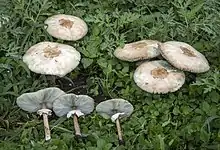Chlorophyllum molybdites
Chlorophyllum molybdites, which has the common names of false parasol, green-spored Lepiota and vomiter, is a widespread mushroom. Poisonous and producing severe gastrointestinal symptoms of vomiting and diarrhea, it is commonly confused with the shaggy parasol or shaggy mane, and is the most commonly consumed poisonous mushroom in North America.[1] Its large size and similarity to the edible parasol mushroom, as well as its habit of growing in areas near human habitation, are reasons cited for this. The nature of the poisoning is predominantly gastrointestinal.
| Green-spored parasol Chlorophyllum molybdites | |
|---|---|
 | |
| Chlorophyllum molybdites | |
| Scientific classification | |
| Kingdom: | |
| Division: | |
| Class: | |
| Subclass: | |
| Order: | |
| Family: | |
| Genus: | |
| Species: | C. molybdites |
| Binomial name | |
| Chlorophyllum molybdites (G. Mey.) Massee (1898) | |
| Synonyms | |
|
Agaricus molybdites | |
| Chlorophyllum molybdites | |
|---|---|
float | |
| gills on hymenium | |
| cap is flat | |
| hymenium is free | |
| stipe has a ring | |
| spore print is green | |
| ecology is saprotrophic | |
| edibility: poisonous | |
Description
It is an imposing mushroom with a pileus (cap) up to 40 cm in diameter, hemispherical and with a flattened top. The cap is whitish in colour with coarse brownish scales. The gills are free and white, usually turning dark and green with maturity. It has a rare green spore print. The tall stipe may be up to 25 cm tall and bears a ring. This mushroom lacks the snakeskin pattern that is generally present on the parasol mushroom.[2]
Distribution and habitat
Chlorophyllum molybdites grows in lawns and parks across eastern North America and California, as well as temperate and subtropical regions around the world.[3] Fruiting bodies generally appear after summer and autumn rains. It appears to have spread to other countries, with reports from Scotland, Australia, and Cyprus.[4]
Toxicity
Chlorophyllum molybdites is the most frequently eaten poisonous mushroom in North America.[1] The symptoms are predominantly gastrointestinal in nature, with vomiting, diarrhea and colic, often severe, occurring 1–3 hours after consumption.[3] Although these poisonings can be severe, none has yet resulted in death.[5]
Professor James Kimbrough writes on page 325 of his book, Common Florida Mushrooms:
Chlorophyllum molybdites, the green-spored Morgan's Lepiota, is responsible for the greatest number of cases of mushroom poisonings in North America, and in Florida. This is probably due to the fact that it is easily confused with choice edible species such as Lepiota procera and L. rhacodes, and it is one of the most common mushrooms found on lawns and pastures throughout the country, with the exception of the Pacific Northwest. When eaten raw C. molybdites produce severe symptoms, including bloody stools, within a couple of hours. When cooked well, or parboiled and decanting the liquid before cooking, others eat and enjoy it. Eilers and Nelso (1974) found a heat-labile, high molecular weight protein which showed an adverse effect when given by intraperitoneal injection into laboratory animals.
Gallery
 In Osaka
In Osaka Chlorophyllum molybdites
Chlorophyllum molybdites Chlorophyllum molybdites
Chlorophyllum molybdites A young false parasol mushroom
A young false parasol mushroom Chlorophyllum molybdites spore print showing its green color
Chlorophyllum molybdites spore print showing its green color
References
- Beug, Michael W. An Overview of Mushroom Poisonings in North America. Archived 2010-05-20 at the Wayback Machine The Mycophile, vol. 45(2):4-5, March/April 2004
- "How to not pass up a parasol and how not to". Archived from the original on 14 December 2017. Retrieved 24 May 2010.
- Benjamin, Denis R. (1995). "Gastrointestinal syndrome". Mushrooms: poisons and panaceas — a handbook for naturalists, mycologists and physicians. New York: WH Freeman and Company. pp. 351–377. ISBN 0-7167-2600-9.
- Loizides M, Kyriakou T, Tziakouris A. (2011). Edible & Toxic Fungi of Cyprus (in Greek and English). Published by the authors. pp. 132–33. ISBN 978-9963-7380-0-7.
- "Chlorophyllum molybdites". Urban Mushrooms.
External links
| Wikimedia Commons has media related to Chlorophyllum molybdites. |